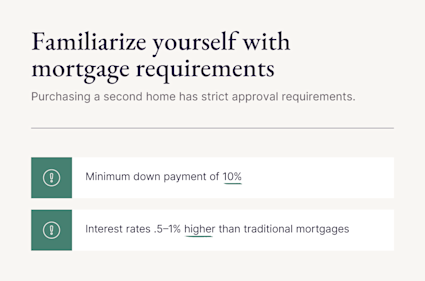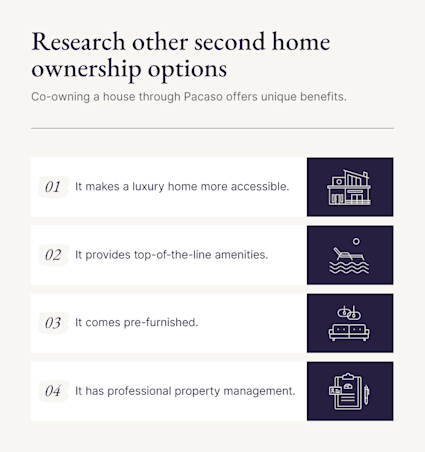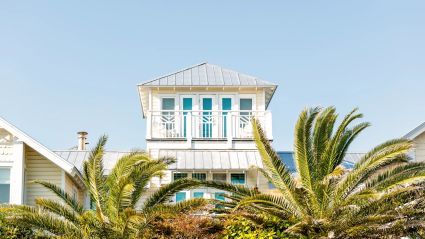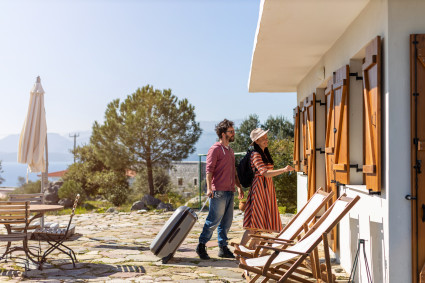How to use the second home mortgage calculator
This easy-to-use calculator breaks the number-crunching down into a few steps. Simply plug in details about your total monthly income and debt obligations, then continue on to determine how much you should spend. The calculator is only as accurate as the numbers you put in, so try to be as exact as possible with your current financial status. Let’s walk through the steps:Step 1
On the first screen, you’ll input some of your financial data to calculate your monthly debt-to-income ratio. As you do, here are the figures you’ll be asked to enter:- Employment income: This is the amount of money you receive from your primary job per month before taxes are withdrawn.
- Supplemental income: Add any money outside of your primary income that you can reliably depend on from month to month. Rental income is a common form of supplemental money, as are investment earnings, child support and alimony.
- Current total monthly mortgage payment: This is how much you spend every month on the mortgage amount for your primary residence. For an accurate representation of your monthly costs, you’ll want to include property taxes and homeowners insurance — not just the principal and interest portions of your mortgage payment.
- Total monthly housing expenses: Enter how much you spend each month on other household-related costs, like utilities and maintenance.
- Monthly debt payments: Total up other monthly payments that go toward debt obligations. This includes things like car payments, credit cards, home equity loans or student loans.
Step 2
On this screen, you’ll see your current debt-to-income ratio (DTI). A commonly used term in real estate lending, DTI is calculated by dividing your monthly debt obligations by your gross monthly income. The lower your DTI, the more favorable you will be seen by mortgage lenders. This screen also shows you your estimated cash on hand. This is the amount of money you have left over each month after deducting recurring expenses.Step 3
This step helps you figure out how much you should spend on a second home. You’ll be asked to input the following information:- Second home down payment: This is the amount of money you’re willing to pay upfront for the home. A larger down payment (20% or more) usually results in a lower interest rate.
- Second home mortgage rate: This is the rate of interest charged by your lender. You’ll want to do some quick research on current interest rates. Note that interest rates on second homes tend to be a bit higher than on primary residences.
- Mortgage loan length: This is the number of years it will take to pay off your loan. The longer the loan, the higher the interest rate.
Step 4
Here, you’ll see your results. Based on all your inputs, you’ll see how much you can afford to spend on a second home. If you’d like to explore Pacaso second homes, you can simply click “View listings” and check out the homes that are available within your housing budget. Now that you’ve done the math, let’s explore how you can make second home ownership work for you.5 factors to consider when buying a second home
Since lenders make money off of interest rates, they are incentivized to offer the highest amount possible to a home buyer. Just because you may qualify for a large loan doesn’t mean it’s in your best interest to accept it in full. Remember that in addition to monthly mortgage payments, second home owners are still responsible for:- Annual property taxes
- Homeowners insurance
- Utility payments
- Possible homeowners association fees
- Regular maintenance
- Mortgage insurance (if your down payment is less than 20%)
1. Know your financing options
Knowing how you plan on paying for your home will help determine what you will be approved for. Here are some of the common routes home buyers take:- Home equity loan: Also known as a second mortgage, home equity loans allow you to borrow against the current equity you have in your home. They provide a lump sum of cash or line of credit for you to make a purchase. If your property loses value, you may owe more on the loan than the property is worth.
- Conventional loan: You can receive these loans through traditional lenders like banks and credit unions. Just like your primary mortgage, you’ll make monthly payments of principal and interest until your loan is paid off.
- Cash: Paying for a home in full will reduce the overall cost of owning a second home because you won’t be paying interest on a loan.

2. Revisit your current financial status
Lenders want assurance that you will be able to uphold the terms of your loan, so they’ll look at your current financial situation.Considering purchasing a second home? A key financial metric to assess is your debt-to-income (DTI) ratio. To comfortably afford a second property, your DTI should ideally not exceed 45%.While this threshold is a general benchmark, having a favorable credit score, a substantial down payment or considerable cash reserves can provide added flexibility. Ensuring that these financial parameters are in check will guide you in making an informed decision about acquiring a secondary residence.Typically, you will need to have a favorable credit score, as anything below 640 could result in a rejected application.3. Understand second home mortgage requirements
The second home buying process is similar to buying a primary home, but it does have stricter requirements. Along with having higher interest rates — usually 0.5% to 1% higher — second home mortgages usually require larger down payments, too. This is due to the greater financial burden a vacation home places on the owner. The rule of thumb is that your housing and debt payments should add up to 36% of your pre-tax income at most. Sticking to this guideline can prevent you from being “house poor,” which means tying the majority of your income up in housing expenses and leaving little cash on hand for unexpected expenses, either related to your second home or not.Be prepared to pay at least 10% of the second home’s value as a down payment. This is substantially higher than the rate for a primary mortgage due to the added loan risk.
4. Know your options for second home ownership
Getting a second home mortgage may be out of reach if your goal is to become the sole owner, but that’s not your only option. Pursuing co-ownership can make up for shortcomings in your financial status and get you into the second home of your dreams. Purchasing your home through a co-ownership model like Pacaso can also provide many benefits that you’d miss out on with traditional methods. For the price of a mid-tier home, for example, you can have a share in a luxury home with all the benefits that come with it, like top-of-the-line amenities, high-end furnishings and a prime location. You’ll simply share ownership with up to seven other owners as part of a multi-member LLC.Pacaso manages the property for you, ensuring it’s flawlessly maintained and stocked with the essentials you need for a relaxing stay. This sort of turnkey ownership allows you to bypass the common hassles — and big price tag — of owning a whole second home on your home on your own.
5. Learn how to increase your borrowing power
After evaluating your finances, you may find that you don’t meet the requirements for purchasing a second home at the moment. The good news is that you have the power to increase your appeal to lenders with just a little time and strategy.- Offer a larger down payment. Your current income may be fixed for the time being, but if you have enough savings, you can pay a greater percentage of the house purchase price in cash. This will reduce your monthly payment and make your loan less risky to lenders, which may give you access to a lower interest rate.
- Improve your credit score. Higher credit scores mean lower interest rates, keeping more money in your pocket every month. Paying debts, including credit cards, on time has the biggest impact on your score, but utilizing 30% or less of your credit line also plays a big role. Or you can try consolidating your debts so that you’re only dealing with a single payment that might have a lower interest rate.
- Improve your DTI. If your current debt-to-income ratio exceeds 43%, focus on paying off some of your debts or finding ways to increase your income, or both.
- Reduce unnecessary spending. Small, individual expenses like eating out add up fast. What small (or not-so-small) luxuries are you willing to forgo in order to secure your second home? If you’re struggling to save for a down payment, take a look at your everyday spending habits and see where you can cut back or find more affordable alternatives.
Key differences between primary residence and second home loans
When you’re exploring a second home purchase, it’s important to understand how financing differs from your first home. While the loan process might feel familiar, second home mortgages come with slightly stricter terms. From down payments to interest rates, here’s how the two compare side by side:| Feature | Primary residence | Second home |
| Minimum down payment | As low as 3% with conventional loans | Typically 10% or more |
| Private mortgage insurance | Required if the down payment is under 20% | Often required if the down payment is under 20% |
| Credit score | Minimum 620 for conventional loans | 640 or higher, with better rates at 700+ |
| Interest rates | Lower, more favorable rates | Often 0.5%–1% higher than primary residences |
A simpler path to second home ownership
When you’re ready to make a second home purchase, Pacaso is ready to help you through the process and connect you with your dream home. Contact us today to learn more.Financing a second home FAQs
01: Can I use a mortgage to pay for a second home?
Yes, there are fixed-rate and adjustable-rate mortgages available for a second home purchase. Whether you can use a mortgage to buy a vacation home depends on your ability to qualify. If you have a mortgage on your first home, you’ll need to show the lender that you can afford to take on a second monthly payment. The application process will include checking your credit profile and credit score and calculating your debt-to-income ratio.
02: Can I deduct mortgage interest on a second home?
Generally, second home owners can deduct mortgage interest on a loan of up to $750,000, as long as you use your second home for personal use — meaning, you don’t generate any rental income. The rules can be complicated, so check with your tax professional.
03: Can FHA or VA loans be used for second home purchases?
No. Government-backed loans like FHA loans and VA loans can’t be used for second home purchases. They’re designed to help make it more affordable to buy a primary residence.
04: Is it harder to get a loan for a second home?
Yes, second home loans often have higher credit score and down payment requirements and stricter DTI guidelines than primary loans.
05: Can you put 5% down on your second home?
It’s rare. Most lenders require at least 10% down on a second home. Lower amounts may be possible with excellent credit, but it’s unlikely.
06: Can you buy a house with no money down?
For a second home, this is extremely difficult. Zero-down loans are typically only available for primary residences through programs like USDA or VA loans.










